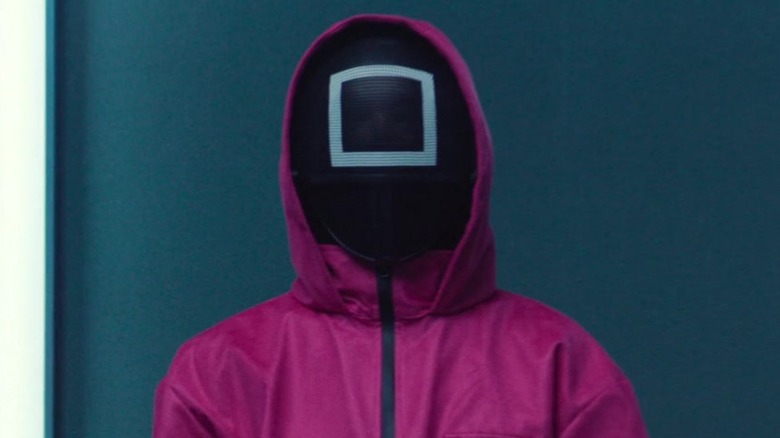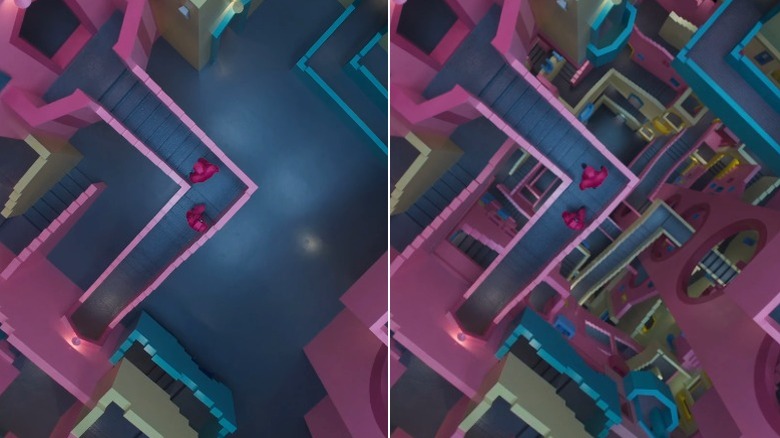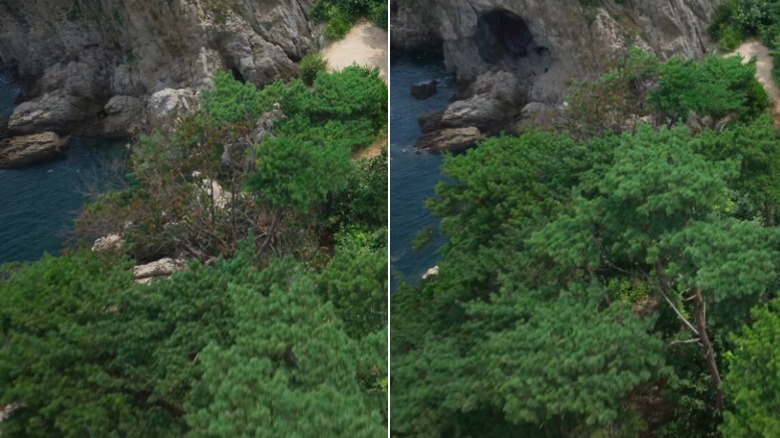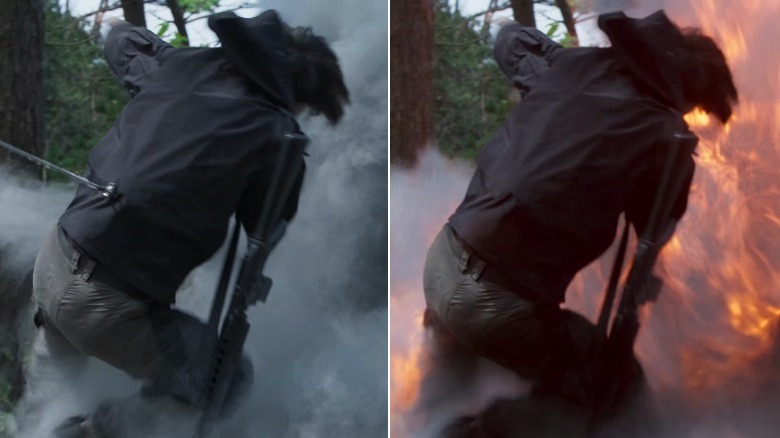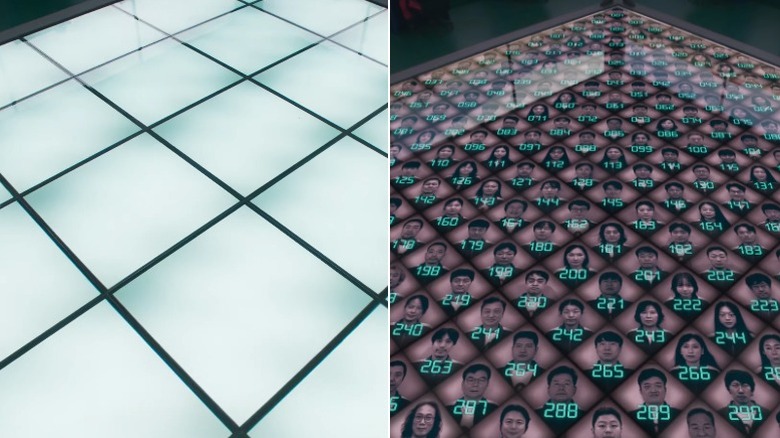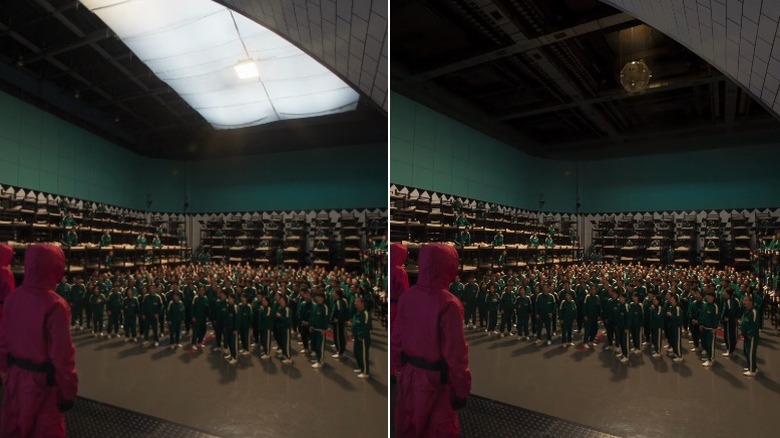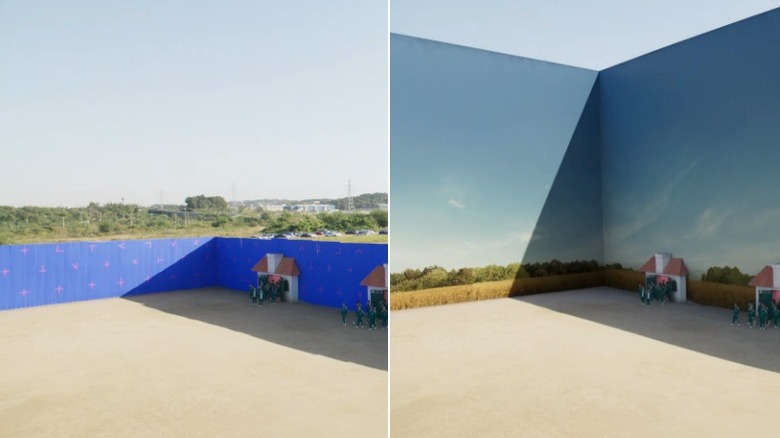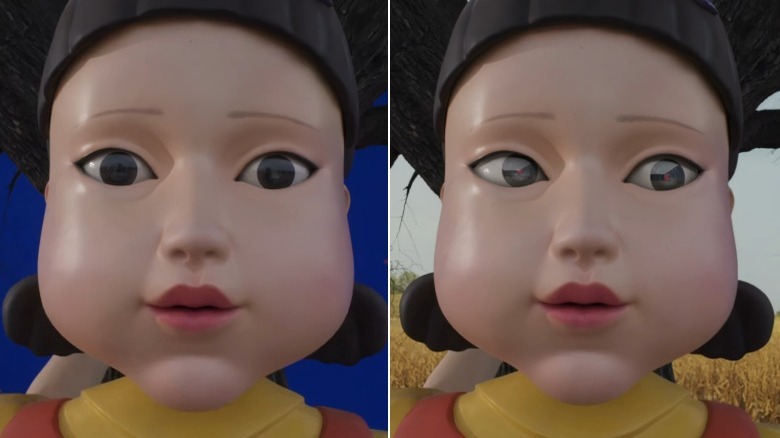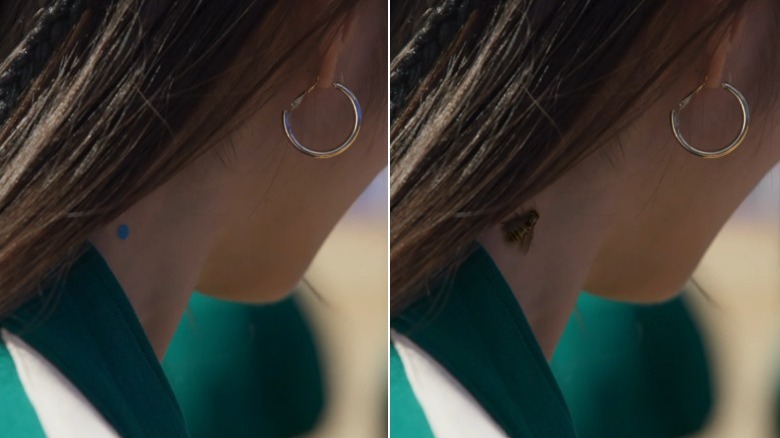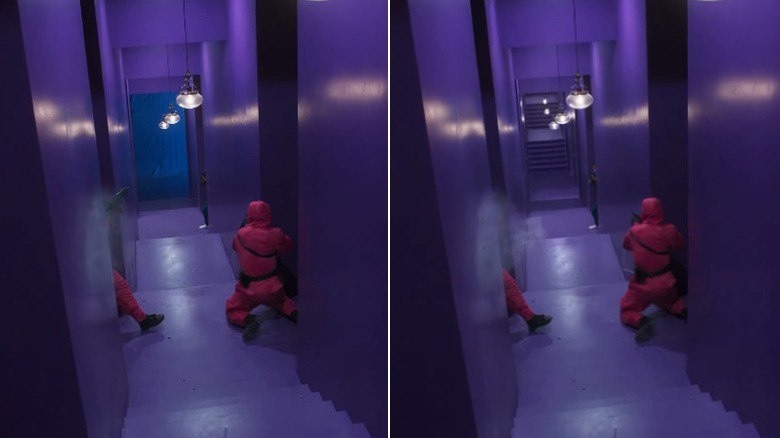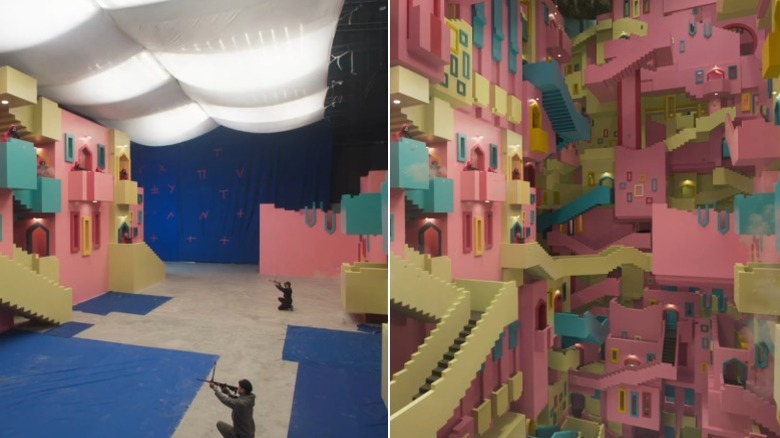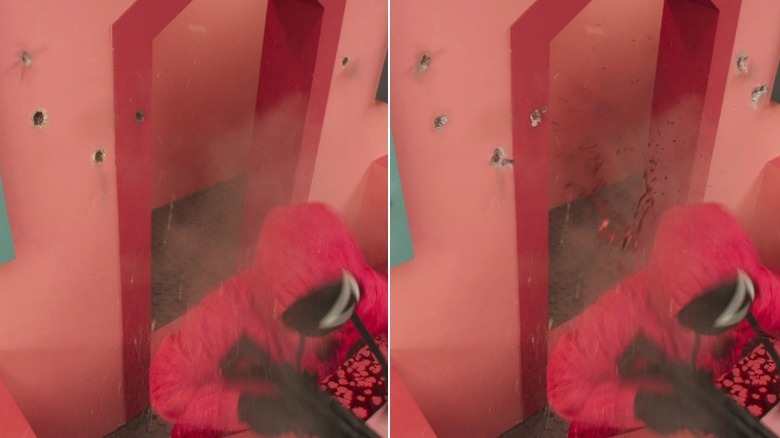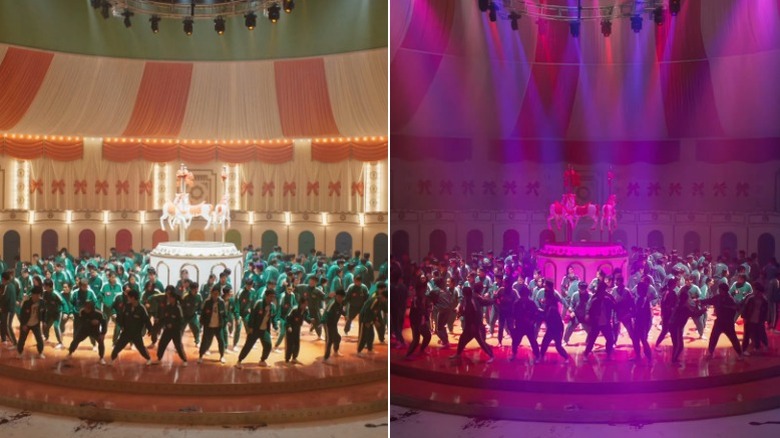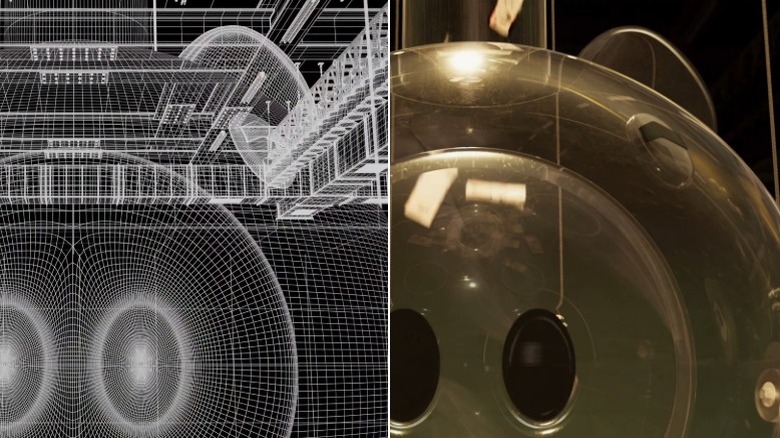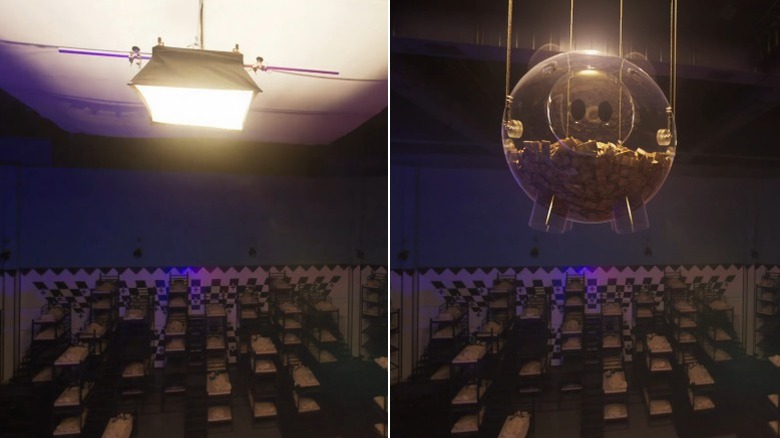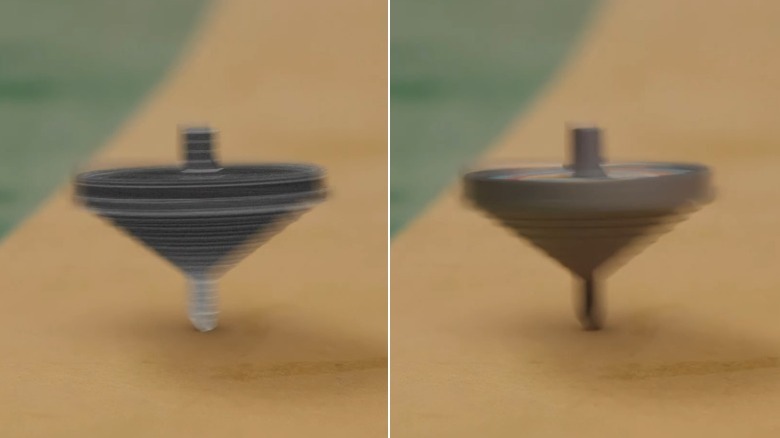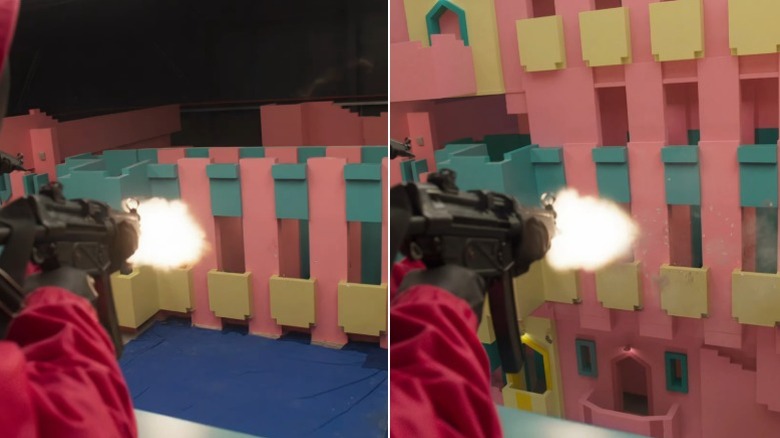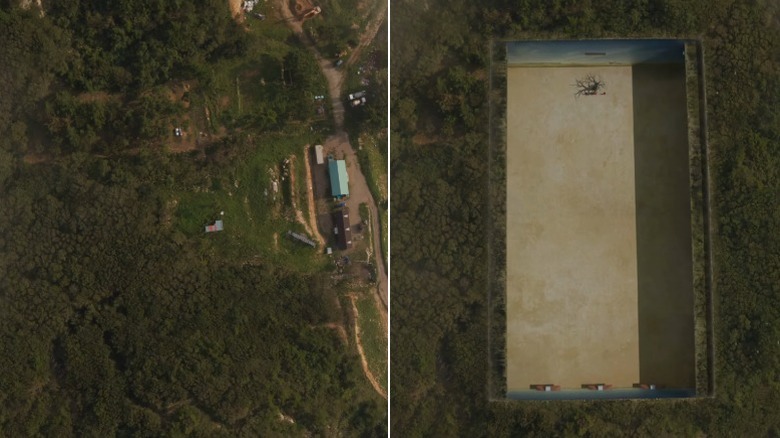What Squid Game Season 2 Looks Like Without Special Effects
Season 2 of "Squid Game" may have proved controversial among critics and fans of the first season — Looper's own Akos Peterbencze deemed it a mildly entertaining but lackluster follow-up — but it still had its strengths. In addition to various small details in Season 2 that should delight and surprise fans upon repeat viewings, the visual design and CGI work were on point as always.
A recently-released showreel by VFX house Gulliver Studios offers several examples of the creativity, thoroughness, and care that went into creating the new season's effects — many of which you may not even have noticed were digital. Here are some of the most interesting examples of what "Squid Game" Season 2 looked like before and after VFX were added.
The stairways were expanded through digital effects
One of the most recognizable design elements on "Squid Game" is the dense maze of staircases, corridors, footbridges, and balconies that players and guards move through within the arena. Inspired by M. C. Escher drawings, per production designer Chae Kyoung-sun, the maze is depicted so as to give off the feeling of near-endless stairs.
But to create that impression, designers had a little help from the CGI team: Although the uppermost structures of the maze are practical sets on concrete floors, they are extended downward with CGI, as can be clearly seen on the above overhead shot. The Gulliver VFX reel features many shots of the maze of stairs that connect the various rooms in the compound, and they're all mind-boggling in their own way — each showcasing the CGI artists' skill at making a limited real-life set look impossibly yet convincingly vast.
The stormy boat scenes were filmed on a set
The scenes aboard the boat belonging to Captain Park (Oh Dal-su) are among the most intense and viscerally thrilling in "Squid Game" Season 2, thanks in no small part to the terrifying nature of open sea navigation.
Given how real the storm scenes in particular feel, you may be surprised to learn that they were in fact filmed in a closed set. More specifically, a practical boat was placed in a controlled studio pool surrounded by blue chroma walls, and then the sea and the storm were created digitally afterward.
The island is real, but the cave isn't
Much of "Squid Game" was filmed on location, and the shots of the secluded island where the game arena is secretly located used various real-life vistas around the island of Seongapdo, a tiny crescent-shaped island off the coast of Incheon, in northwestern South Korea.
Although much of the island's actual geography was used, the cave with dive packs leading right to the ocean did not actually exist; in aerial shots such as the one above, it was digitally added to the side of a rocky cliff.
Some explosions were partly practical
Although the infiltration of Jun-ho's (Wi Ha-joon) team of mercenaries onto the island was a somewhat disappointing storyline that left us with big unanswered questions about the number of bombs left to go off, the Gulliver Studios showreel at least clarifies the nature of the VFX used for the one detonation we've seen.
In the sequence that finds the team accidentally setting off a bomb after opening a hatch, a real explosion was created by the special effects team, and a cable was used to yank back the performer and simulate a shockwave movement. Fiery blasts were then added to the smoke via CGI — nothing wrong with a little augmentation, after all.
The control room was filmed with blank computer screens
The control room from which pink-clad managers keep watch over the entire island, via monitors connected to security cameras, is another impressive piece of production design in the "Squid Game" world. Although a lot of it was practical — stunningly so, given what a massive, complex, and detailed environment it is — the show did circumvent the immense hassle of actually synchronizing in-monitor footage with the action.
Instead, all the security camera screens around the control room, including both the monitors and the larger screens above, were fully blank when shot, and filled in with the proper footage later.
The floor screens were also blank before VFX
The security camera monitors weren't the only part of the control room that was kept blank during filming, either. The centerpiece of the control room — the floor screens displaying headshots of every single one of the Squid Game players along with their player numbers — also consisted of a litany of blank screens in real life, with the content of the screens being added in later.
Much like the monitors, the practical floor screens were bright white, possibly to simulate the lighting effect that would be created by the in-universe display of pictures.
The Gyeonggi skyline was changed digitally
The exterior of the Pink Motel in Seoul, which Gi-hun (Lee Jung-jae) uses as a front for his operations throughout Season 2, and to which Jun-ho eventually tracks him down, was filmed on a real-life location with only minimal digital alteration. It's the front of a real-life motel located in Guri, a city right next to Seoul in the Gyeonggi Province.
The main changes made by the VFX team were removing two stories from a building on the same street, replacing it with a view of the Gyeonggi skyline and a passing train, and changing the writing on the motel sign to "PINK."
Keying effects were used on the ceiling
The cramped, prison-like compound dormitory in which the players sleep is a practical set on Season 2 of "Squid Game," much like it was on Season 1. Even the ceiling is very similar to what it looked like in real life, complete with industrial metal beams. But the transparent piggy bank in which the prize money accumulates was added in via CGI.
A large sheet of white lining and a carefully-placed light were used to facilitate the proper keying — which is the isolation of elements in an image by their color or brightness — and then it was all a matter of everyone in the scene convincingly pretending they were looking at an enticing pile of cash. In real life, the actors were just looking at the sheet and the light box used to illuminate the set and provide reference points for the VFX team.
The Red Light, Green Light arena was a plain, empty lot
One could make a case that the first game arena — where the bloody Red Light, Green Light game is played in both seasons — is the most terrifying one in all of "Squid Game." Its open roof and insurmountably high walls covered with pictures of a serene landscape — those walls and landscapes the work of the CGI artists — all but mock the players' entrapment, taunting them with a false sense of openness and contact with the outside world.
In real life, the arena was filmed on an equally large but considerably less grandiose empty lot, most likely located in the city of Daejeon, where most of the show's sets were constructed. What we see of the arena's sandy floor is about 90% taken from the real-life ground. The house-shaped gates through which the players emerge into the game hall were also real. Add an intimidating digital clock on the wall and a few CGI players to round out the crowd, and you've got yourself a memorably claustrophobic set.
The doll's eyes were computer-animated
If one were to put a single face to the "Squid Game" cultural phenomenon, it would have to be a non-human one — namely, the face of Young-hee, the giant robot doll who fires at the players during the Red Light, Green Light games.
A real-life Young-hee was built and placed on the arena set for the filming, but one particular detail in her design was accomplished via CGI: The movement of her eyes, which constantly scan the arena in search of any movement. Ironically, the dead-eyed, real-life version of Young-hee is still somehow deeply terrifying in her own way.
A blue dot was used to animate the bee
"Squid Game" is a gut-wrenching show at any given time, but the demise of Mi-na, aka Player 196 (Song Ji-woo), done in by the bee that lands on her neck and causes her to flail around in panic during the first game, was particularly heartbreaking to watch — albeit laced with some measure of dark humor.
To film the scenes, the VFX team placed a small blue dot on Song Ji-woo's neck, and used it as a reference for the CGI animation of the bee. The Gulliver reel also showcases the attention to detail that comes with CGI work: Take a look at Mi-na's hoop earring, and you'll notice that the CGI team had to remove the blue reflection of the chroma walls.
Even the corridors were extended with CGI
If the stair maze is immense and overwhelming, the smaller, more modest corridors leading in and out of rooms in the "Squid Game" compound are oppressive and claustrophobic — and Season 2 gives those corridors a good workout by placing the climactic shootout sequence within them.
In one specific shot, the far-off staircase that extends one corridor and intensifies its labyrinthine nature was added in digitally — along with a new string of hanging lights matching the practical ones — where there once was just a plain blue chroma screen.
One of the shootouts used reference snipers in a floating place
The above shot from the Gulliver showreel is especially helpful in laying out what a grand feat of make-believe the "Squid Game" maze was. As seen during the shootout towards the ending of Season 2, the maze essentially consists of "walls" lined with balconies and stairs, and a big empty atrium in the middle.
In real life, not only was one of the perpendicular walls almost entirely computer-generated, but performers with prop guns had to be placed in the middle of the "atrium" space, to be removed later using CGI, as references for the sniper action.
The guard? Real. The blood? Not so much
The shootout sequence gave CGI artists the opportunity to play around with plenty of blood and splatter, and one shot is notable for being almost entirely real save for that gory detail.
Standing on the maze set, with the camera closing in on just the practical balcony, a pink guard holding a gun gets shot at. The guard is played by a real performer; the bullet holes on the wall behind him are real, albeit slightly altered via CGI; the blood that comes flying out of the guard's body, however, is CGI blood. No actors were harmed in the making of this shot.
CGI lights were added to a practical carousel
The merry-go-round hall in which the players are forced into playing Season 2's best new game, Mingle, was practical — but the same can't be said for the lighting used in that scene. The blue and red colored lights that get cast on the players, blending together into club-esque pink and purple hues that further accentuate the irony of their tragic circumstances, were added in digitally.
To accomplish that, of course, the scene's lighting design had to be carefully planned to produce shadows and reflections in the correct places.
The piggy bank was carefully rendered in CGI
"Iconic" is the right word for the transparent piggy bank that hangs over the players' heads throughout the games; no other visual captures the garish reality-TV-gone-mad energy of "Squid Game" so perfectly.
Although the piggy bank looks entirely real and tactile on the show, you can thank the VFX team for its memorable screen presence; as demonstrated on the above shot, it's all CGI in most shots — and, before looking convincingly like a real-life prop, the piggy bank had to go through several stages of digital rendering.
The lighting for a piggy bank shot was kept as real as possible
Although the piggy bank is entirely CGI in every shot featuring it in the Gulliver reel, that doesn't mean the filmmakers didn't have to think practically when planning out the effect.
This shot of the dormitory as seen from the height of the piggy bank reveals that the lighting for the scene was almost entirely practical — meaning the light box was placed in the exact spot to emit light into the room in precise accordance with the light being shed from above and refracted through the piggy bank in-universe.
The spinning top was a 100% CGI creation
One of the new games featured on Season 2 of "Squid Game" is the six-legged pentathlon, in which five players, tied together, have five minutes to complete five children's games in order to advance all the way around a rainbow-colored track — a scene so arduous to film in real life that it made some of the actors sick.
One of those games, paengi chigi, consists of winding a fiber rope around a spinning top and then successfully launching it and making it spin for a few seconds. The VFX reel reveals that, in close-up shots of the top spinning, it was animated completely via CGI (the image above depicts an unrendered model on the left). Probably much easier than getting a top to spin in real life.
X marked the spots on the blue chroma walls
The players may have been the targets of Young-hee's merciless killer gaze during the Red Light, Green Light game on "Squid Game" Season 2, but, in real life, X marked the spot somewhere else.
In standard chroma keying practice, the lateral walls of the arena set were covered in cross-shaped markings, to function as reference points for the subsequent digital addition of the landscape wallpaper as the camera and the players moved around. Funnily enough, the crosses appear to have been almost the exact same shade of pink as the in-universe finish line.
Performers had to fire at empty balconies
Even performers without speaking parts have to indulge in a good dose of make-believe on a show like "Squid Game." The shootout sequence in Season 2 featured several instances of pink guard actors firing — or, more accurately, pretending to fire — guns at empty balconies, as though there were anything to hit behind them or anywhere in their vicinity.
The real-life set was a little less elaborate in terms of possible trajectories — as seen above, some of the staircases ended on the concrete floor instead of continuing into ever-loopier forms and directions — but must still have been a blast for the guard actors to shoot in (no pun intended).
A skyscraper became a giant wall
The above shot, in which Gi-hun and Hyun-ju (Park Sung-hoon) look up at one of the island's massive walls, was filmed on a real location. The wall was created via CGI and placed where there previously was a mirrored-glass skyscraper.
If you think a straight blue wall would be simple to animate with CGI, you'd be surprised at the number of layers of rendering the animation in question had to go through.
The Seongapdo woods were reshaped into an arena
One overhead view of Seongapdo, the real-life island that was used as a practical location for shots of the game island on "Squid Game" Season 2, had to be dramatically modified in post-production to accommodate the Red Light, Green Light arena.
Man-made constructions within the shot were removed and the area's forest covering was digitally altered, the better to enable the shot where the ground opens to reveal the rectangular pit and the sand-coated game hall within it.
